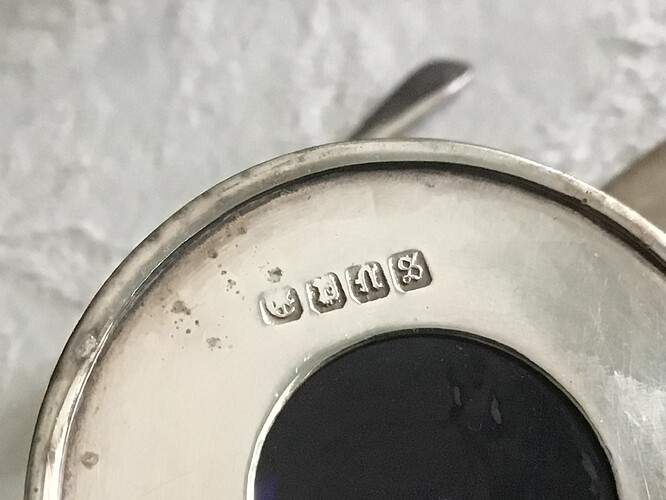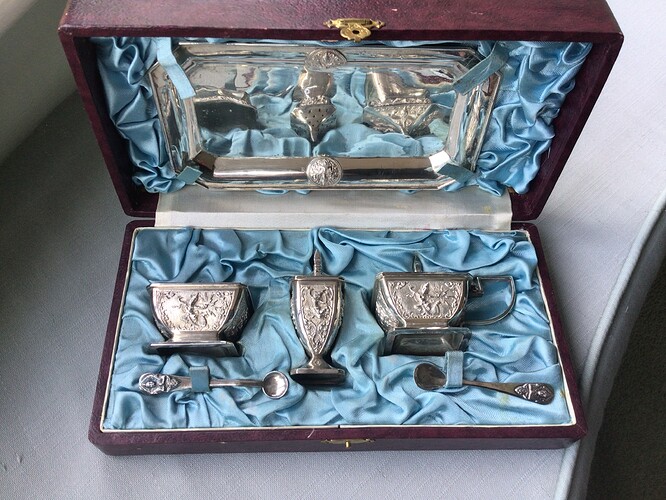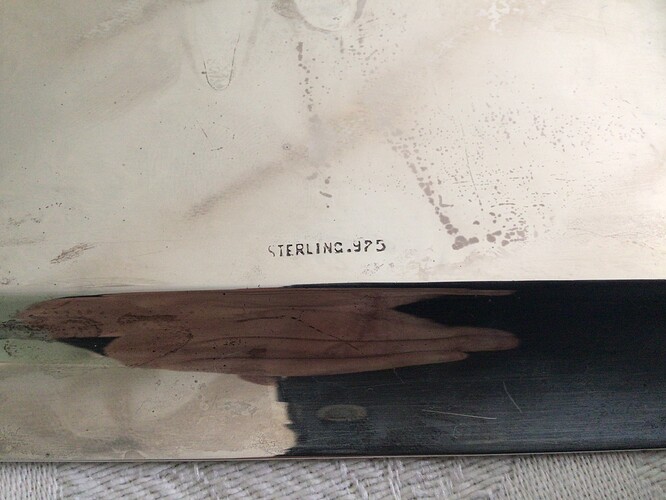Please could someone help with this? It is on a three piece cruet set, possibly bought in Thailand in the 1950s.
Thank you
It says EPNS, which means electroplated nickel silver. In other words, inexpensive silver plate.
“Nickel silver” contains no silver - it’s an alloy of nickel, copper, and zinc. So the only silver is in the plating, which is microscopically thin. Probably no more than a couple of grams on the entire cruet set.
Thank you Jeff.
There I was trying to decipher those unusual symbols, when it was just a fancy way of writing EPNS!
They often use that Olde English font to give it some panache. Once you’ve seen it a couple of times, you recognize it in a heartbeat! ![]()
I wonder if you could help with another item, please? I was given it to sell for a charity but don’t know what it might be worth.
It’s another cruet/condiment set with a tray, from Thailand in the 1950s.
The tray and two glass-lined items are stamped Sterling 925. The central item and spoons have no stamp but match the decorations on the stamped ones.
That’s going to be a tricky one. Please give us a clear, closeup photo of any markings that appear.
If there’s nothing other than “STERLING 925,” it might be sterling. Or it might not. It might just be a fake. Some identification of the maker could provide some clarity.
You are very kind, I appreciate it.
Unfortunately the box has no makers name, and the three stamped items only have the stamp shown in the photos.
Dodgy. I’ll have to leave this to someone who has more knowledge about the reliability of SE Asian sterling.
In the U.S. or Canada, stamping something “sterling” that isn’t would get you a fraud charge. In the U.K., it’s almost a hanging offense. ![]()
But in some places, it would be regarded simply as “smart marketing.”
If it’s actually sterling, you can get some notion of the value by weighing the whole set and checking the current spot price of silver, currently about $0.95 or £0.72 per gram. That gives you a floor value - the melt value, as scrap silver, would be a bit less than that, to allow the dealer some margin. If the set is not by a known maker, it probably wouldn’t sell for much more than.
Thank you for taking the time to help. I won’t rush into anything!
If the item is marked “STERLING .975” and you bought it or someone did in The Far East Mr Tucker is right. Treat it as white metal. Sterling of course is .925 meaning 92.5% silver and the rest base metal. The advertised .975 would be 97.5% silver or higher that the French or Minerva standard of 95.00% and even the Britannia Standard of 95.8% silver adopted by the British to stop coin clipping or even melting down of .925 or sterling coins to create domestic silver or tableware. This higher standard was abandoned in 1720 under pressure from Goldsmiths and their clients who wanted the finer more complex modern styles which were difficult to render in the softer metal.
The supplemental question which is touched upon is are you breaking any laws reselling it “as is where is”. In the UK possibly, In the US or Canada probably not. But if you flog it on ebay or in some other forum where the buyer feedback section can bite you in the proverbial I would tend not to.
Christopher Wilson
Guildhall Antiques
Toronto.
It isn’t entirely clear whether the marking is .975, or a rubbed or poorly punched .925. The lower part of the 5 is also missing.
But Japanese silver, for example, is often .998 or even .999. Too soft for jewelry, but they do make other items of that purity. Very soft, and prone to damage, but it really is almost pure silver (1.000 can’t be achieved).
Thank you for reading my post and responding with such rapidity.
Luckily we have three separate stamping of the probably bogus mark. On the dish or larger item the .975 mark seems as clear as a photograph of silver can ever be.
To be honest, Mr Tucker, I am not sure I would be entirely comfortable joining you in defending who ever punched this mark and I am completely certain it is not high ratio Japanese temple silver.
In the 1950’s Thailand was an R&R area for US and some commonwealth troops engaged in that still unfinished war between North and South Korea. An enormous amount of souvenir items were produced for the cash rich guests. Most of it was rather good. Some of the post war Niello pieces produced out of the shops of the Surin district of Bangkok are highly sought after by collectors. In Japan in the same period the US military rules under McArthur tightened up on the silver production governance to protect against exactly this sort of rather dubious representation.
CRWW
Probably true, but I think I’d have it tested before binning it.
ETA: And if it doesn’t test out to be sterling, the proper thing to do with it would be to take a large mallet to it, bash it into lumps, and then bin it. A fake like that shouldn’t be allowed to reenter the stream of commerce.
I believe that on the Chinese version of the Antiques Roadshow, that’s what they do with fakes and knock-offs. They’re demolished on the spot. Great entertainment, and the U.K. and U.S. versions of the show should follow suit. ![]()
Thank you both for helping. I will definitely have this tested before attempting to sell. I have a very good positive feedback rating on eBay which I would not want to sully with anything negative!



